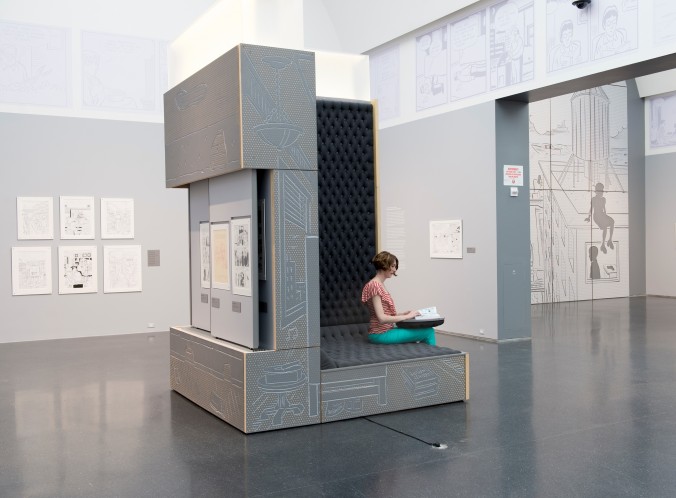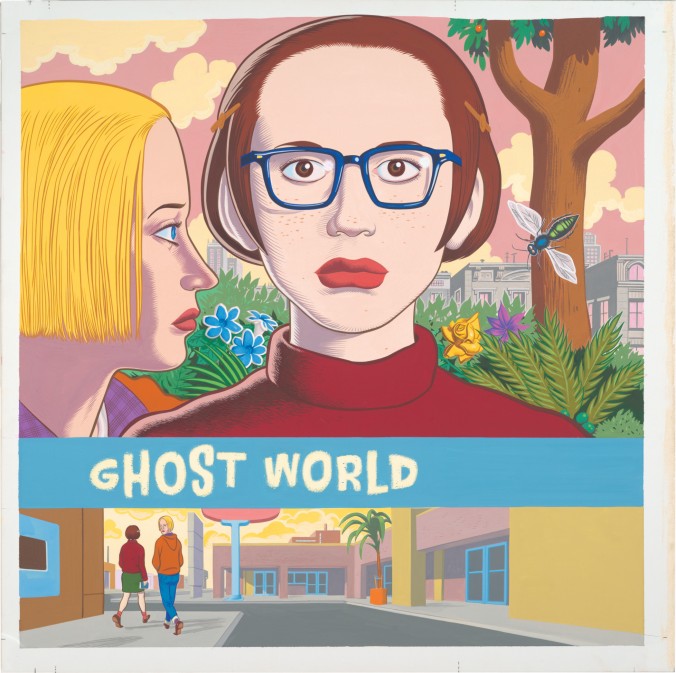…of the Atypical Teenage Girl
“Modern Cartoonist: The Art of Daniel Clowes,” currently on view at the Museum of Contemporary Art Chicago, showcases over 160 of the artist’s original drawings, cartoons, comic book series, and graphic novels. The exhibition was originally organized by the Oakland Museum of California and then traveled to the MCA, where it underwent considerable development through Nicholas de Monchaux’s exhibition design. The gallery walls complement the intensely hued comics and caricatures with a neutral, metallic finish, like that of a structuralist’s idea of a Victorian parlor.

What interests me most here are the rare colored pencil illustrations from the graphic novel “Ghost World,” unique because the artist typically works in black ink. “Ghost World” (2006) and “Ghost World” (2007) hang on one side of a kiosk with a poster display of Clowes’s work, where guests can flip through like they could choose one for their room. The drawings depict a scene in which best friends Enid Coleslaw and Rebecca Doppelmeyer are in the midst of a quarrel, spouting off a lachrymose exchange of insults such as “bitch” or “fuck you.” They launch into these endearing phrases to damage each other while mutually suffering internally at the same time.
This specific sect of camaraderie is unique to females. How Clowes came to understand it enough to not to just write about it, but DRAW it completely baffles me! Perhaps the vernacular used in his graphic novel could be shrugged off as an exemplary example of the contemporary teenager’s everyday jargon… or he’s actually one of them. Clowes’ perspective on a specific demographic of young, unusual women is spot on.
“Ghost World” was published as a graphic novel in 1997 amidst the era of MTV’s animated television show, “Daria,” and Alan Martin and Jamie Hewlett’s comic “Tank Girl.” Though these infamous cartoons may not have influenced Clowes directly, he was certainly influenced by women like the main characters. In “Daria,” Daria Morgendorffer is a sarcastic, misanthropic high school student who voices and shares critical social commentary of her teachers and classmates with her best friend, Jane Lane. Similar to Enid in “Ghost World,” Daria refuses to accept the conventional moral standards and values of popular culture in the twentieth century. Like Clowes, Glenn Eichler and Susie Lewis Lynn, the creators of “Daria,” developed a strong, opinionated female character with a sophisticated humor. In an article that appeared in the Chicago Tribune TvWeek in August 1998, Jennifer Mangan wrote, “Daria and Jane share the same jaded view of the world and feel empowered by their cynicism. Everyone else is portrayed as artificial, dysfunctional, self-absorbed and stupid.” Enid and Rebecca display a coinciding satisfaction to Daria and Jane in their own apprehension of their environment and their refusal to approve of the general public’s cultural values.

In Mangan’s article, “‘Daria’: Brainy=Zany in MTV’s irreverent view of ‘girl humor,'” she quotes Susie Lewis Lynn’s thought on Daria’s world view: “It’s all part of this big defensive mechanism Daria has because she is a misfit in her world…While Daria is laughing at the rest of the world and acting as though she is above all the other characters, she has put herself there as a defense from being rejected from them on a daily basis.” Enid specifically wouldn’t exist without the stifling suburban scenery or the lack of “humanity” that she finds so appalling. She doesn’t fit in and has consciously chosen not to. Like Daria, Enid finds a way to make rejection a part of her daily routine so that she’s never vulnerable to actually being rejected.
“Tank Girl,” the British comic created by Jamie Hewlett and Alan Martin, has no plot or character development that is particularly analogous to “Ghost World.” “Tank Girl” is a about a young female bounty hunter who drives a tank, brandishes a firearm and is depicted as a tenacious, able-bodied, rebellious, sexual deviant that demonstrates stereotypical “male” behavior such as flatulence, nose picking, violence, and spitting. This is the antithesis of the typical, banal expectations of women and correlates to Clowes’s success in creating such exclusive characters as Enid and Rebecca in a “popular” communicative form.
In the introduction to “Ghost World: Special Edition,” Clowes writes about his wife, Erika, as the inspiration for Enid’s character and dedicated the graphic novel to her. In an interview by Austin English for Indy Magazine in 1999 Clowes explained, “I knew a lot of girls who were very similar to [Enid and Rebecca]…And I realized that girls were not being depicted as I had known them, which was a lot more like boys. Sort of like sexually aggressive, and just…swearing and obnoxious. You don’t see that. Girls are always sort of sweeter, these dumb, kind of catty valley-girl types, like in ‘Clueless.'”





